
The Phaneropterinae, the sickle-bearing bush crickets or leaf katydids, are a subfamily of insects within the family Tettigoniidae. Nearly 2,060 species in 85 genera throughout the world are known. They are also known as false katydids or round-headed katydids.
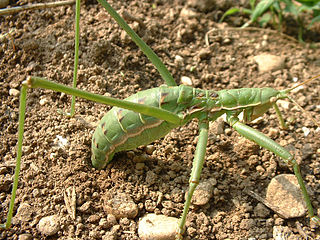
Saga is a genus of bush crickets or katydids containing around 15 species as of 2018. It is the only genus in the tribe Sagini and belongs to the subfamily Saginae. Species have been recorded from southern Europe and western and central Asia.

Markia hystrix is a species of katydid in the subfamily Phaneropterinae. It occurs in highlands of western and central Colombia and in southern Panama, up to an altitude of at least 1,800 m (5,900 ft); although sometimes reported from elsewhere, this is due to confusion with other species in the genus Markia, all of which are known as lichen katydids. These highly spiny katydids are very well camouflaged, with colors and patterns that closely resemble the Usnea lichen upon which they live and feed. Adult M. hystrix have a length of about 4.5–5 cm (1.8–2.0 in) and show some variation in color depending on the exact color of the lichen in a region.

Scaphura is a Neotropical genus of bush crickets in the subfamily Phaneropterinae. Some of the species within Scaphura are Batesian mimics of wasps, for example the type species, Scaphura nigra, is a polymorphic Batesian mimic of wasps of the genus Pepsis and Entypus (Pompilidae) and the potter wasps Polistes (Vespidae). The genus is restricted to South America. Another genus of Neotropical phaneropterine bush crickets, Aganacris, also are Batesian mimics of wasps.

Austrosaginae, the sluggish katydids, are a subfamily of Australian insects within the family Tettigoniidae.

Gryllidea is an infraorder that includes crickets and similar insects in the order Orthoptera. There are two superfamilies, and more than 6,000 described species in Gryllidea.
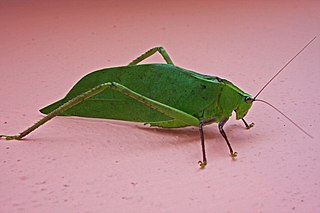
Stilpnochlora is a genus of phaneropterine katydids in the family Tettigoniidae, native to tropical and subtropical parts of the Americas. There are about 15 described species in Stilpnochlora.

Tafalisca is a genus of silent bush crickets in the family Gryllidae. Records for described species in Tafalisca are mostly from Central and South America.
Montezumina is a genus of phaneropterine katydids in the family Tettigoniidae. There are at least 30 described species in Montezumina.
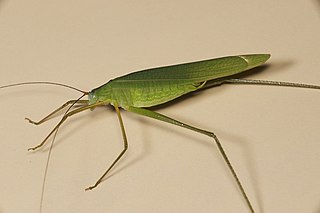
Elimaea is a large genus within Tettigoniidae, the bush cricket or katydid family. Species in this genus are found in India, southern China, Indo-China and Malesia.
Zulpha is a monotypic genus of bush crickets containing only the species Zulpha perlaria.
Paraducetia is a genus of Asian bush crickets that belong to the subfamily Phaneropterinae and the tribe Ducetiini. The two known species have been recorded from southern China and Indo-China.
Orthelimaea is a genus of Asian bush crickets in the subfamily Phaneropterinae. Species in this genus are found in India, Indo-China, and Malesia.
Psyrana is a genus of Asian bush crickets of the tribe Holochlorini within the subfamily Phaneropterinae. They occur in Sri Lanka Indo-China, China, Korea, Japan, and Malesia to New Caledonia.
Anabropsis is a genus of king crickets in the tribe Anabropsini. They are found tropical areas of the Americas, Africa and Asia.
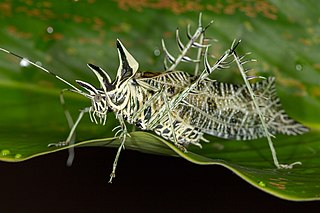
Markia is a genus in the family Tettigoniidae, sometimes called lichen katydids, which are found in Mexico, Central America and South America, often in highlands; however, the term "lichen katydids" is also used for other genera in the tribe Dysoniini. As suggested by the name, the spiny Markia katydids live and feed on Usnea lichen, and their shape and color pattern provides them with an excellent camouflage in this habitat. They are quite large, with adults typically 4.5–6.5 cm (1.8–2.6 in) long.
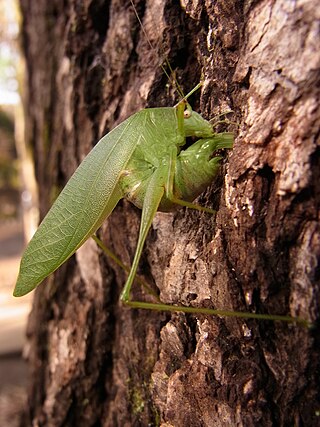
Holochlora japonica, the Japanese broadwinged katydid, is a species of katydid or bush cricket native to eastern Asia in the large subfamily Phaneropterinae.

Orophus tessellatus, the false leaf katydid, is a species of katydid native to Mexico, Central America, and South America. It is in the large subfamily Phaneropterinae within the tribe Amblycoryphini. Its coloring varies from brown to green, some with spots, mottling, or uniform in coloration. The body length reaches 16 mm (0.63 in) in males and 22 mm (0.87 in) in females. The ovipositor is approximate 7 mm (0.28 in) in length. The species is characterized by the size of the forewings and their "dirty" coloring.
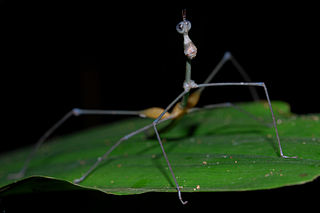
Proscopiinae is a subfamily of grasshoppers in the family Proscopiidae. There are more than 20 genera and 190 described species, found in South America.
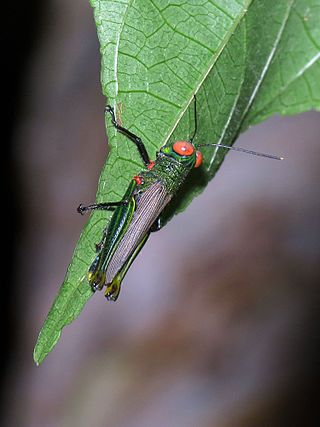
Proctolabinae is a subfamily of grasshoppers in the family Acrididae. There are more than 20 genera and 210 described species which are found in South America.














